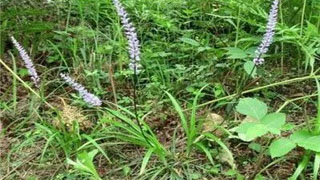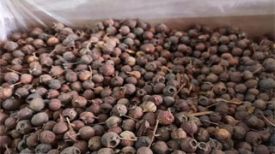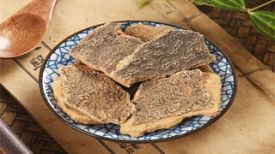
Nicknames: Oyster Mother, Lianmu, Wild Polygonum, Ground Ginseng
Harvesting and processing: Harvesting and digging in spring and autumn, removing dead leaves and roots, shaking off soil, drying or drying to make "Mao Zhi Mu". Peel off the outer skin while fresh and dry it in the sun to make "Zhimu meat" (light Zhimu).
Medicinal parts: rhizome
Origin: Northeast, North China, Shaanxi, Ningxia, Gansu, Shandong, Jiangsu, etc
Family: Liliaceae
Original plant: Zhimu
Plant condition: Perennial herb
The whole plant is hairless. The roots and stems are abundant, thick, and densely covered with many yellow brown fibrous leaf residues, with many fleshy fibrous roots growing underneath.
Leaves are basal, clustered, linear, 20-70cm long, 3-7mm wide, green on top and dark green on bottom, hairless, slightly hard in texture, and the base of the leaves expands to cover the rhizomes.
The scape is upright, unbranched, 50-120cm high, with lanceolate degenerated leaves at the lower part and sparse scale like bracteoles at the upper part; 2-6 flowers clustered together, scattered on the upper part of the stem in a raceme, 20-40cm long; The flowers are yellow white, slightly white after drying, more often open at night, with short stems; 6 floral petals, slightly connected at the base, arranged in 2 rounds, oblong, 5-8mm long, 1-1.5mm wide, slightly inwardly folded at the tip, thin at the edge, with 3 light green longitudinal veins; Developing stamens 3, attached to the middle part of the inner whorl, with yellow anthers, degenerated stamens 3, attached to the base of the outer whorl, without anthers; Pistil 1, ovary long ovate, 3-chamber, style short, stigma 1
The capsule is oval in shape, measuring 10-15mm in length and 5-7mm in diameter. When mature, it splits into three segments along the ventral suture line, with each segment containing one seed. The seed is oval in shape, with 3 edges and a pointed end, measuring 8-12mm in length and black in color. The flowering period is from May to August. The fruiting period is from July to September.
Characteristics of Zhimu medicinal herb: Mao Zhimu is a dried rhizome with skin, which is flat cylindrical in shape, slightly curved, with one end thicker and one end thinner, occasionally 2-3 branches, measuring 3-17 centimeters in length and 0.8-2 centimeters in diameter. There are light yellow leaf and stem scars on the root head, commonly known as "Golden Baotou"; There is a sunken longitudinal groove in the center above, with tightly arranged circular nodes densely covered with golden yellow flat hairs, which concentrate from both sides towards the top of the rhizome; The other side is more wrinkled and has many small circular root marks with depressions or protrusions, with little or no yellow fuzz. Hard texture, easy to break, yellow white cross-section, flat. Odorless, sweet and bitter in taste, with stickiness.
Guangzhimu, also known as Zhimu Meat. Dry roots and stems that have been peeled. Thinner than Mao Zhimu, about 3-13 centimeters long and 1 centimeter in diameter. The surface is yellow white or light yellow brown, with twisted longitudinal grooves, and many irregular scattered small root marks can be seen on one side. Hard in texture, easy to break, with a white or yellow white cross-section, some showing muscle and vein points, and mucous after immersion in water. The scent is similar to that of Mao Zhimu.
Premium Mao Zhimu: It is best to have a large, hard texture, a surface covered with golden yellow fur, and a yellow white cross-section. Guangzhimu: It is best to have a plump, moisturizing, hard texture, yellow white color, and a sticky texture when chewed.
Poor quality products that are thin, long, flat in shape, with gray black outer hair and dark inner color are considered inferior.
Medicinal properties of Zhimu:
In this sutra, the taste of Zhimu is bitter and cold. It is mainly used to quench thirst and heat, eliminate evil qi, relieve limb swelling, lower water, supplement deficiency, and nourish qi. Oyster mother, Lianmu, Wild Polygonum, Ground ginseng, Water dredging, Water ginseng, Goods mother, Oyster mother
Bitter taste, cold qi, start with Taiyin lung and Foot Sun Bladder Meridian. Clearing gold and relieving heat, quenching thirst and eliminating annoyance.
The combination of "Shanghan" Baihu Tang (formula in gypsum), "Jinkui" Suanzaoren Tang (formula in jujube kernel), and "Guizhi Shaoyao Zhimu Tang" (formula in Guizhi) is used to clear gold and relieve fire, moisten dryness and relieve annoyance.
Knowing the bitter and cold nature of a mother, she specializes in clearing the heart and lungs while eliminating restlessness. She uses it in various ways to relieve the heat of the upper burner
Those who severely damage the spleen and stomach and cause diarrhea in the large intestine, have weakened fire and soil moisture, and have insufficient stool should avoid it. Later generations of mediocre workers used this method to treat various internal injuries and diseases, extinguish fires with water, and save lives. It has not been completely eradicated to this day. Its various indications: ejaculation of the large intestine, clearing of the bladder.
【 Origin 】 It is abundant in rivers, valleys, and streams in China, as well as in Chuzhou and Jiezhou. It is a perennial grass root that grows vigorously and resembles evergreen.
[Taste] Bitter in taste, cold in nature, non-toxic.
【 Indications 】 Zhimu is a cooling and antipyretic medicine, which has the functions of clearing lung fire, clearing stomach fire, reducing swelling and promoting bowel movements.
【 Additional Record 】 Used to treat cold, long-term malaria, irritability, fever, evil qi under the lower abdomen, evil in the diaphragm, and wind and sweat internal mallei. Taking it frequently can cause diarrhea.
Zhen Quan is restless and stuffy, experiencing bone heat and fatigue, postpartum diarrhea, and kidney qi fatigue. Hate cold deficiency and annoyance.
In the Ming Dynasty, the heat and labor transmitted body heat and pain, cleared the small intestine, eliminated phlegm and cough, moistened the heart and lungs, and relieved the fear.
【 Elements 】 Cooling the heart and removing heat, treating Yangming fever, relieving bladder and kidney meridian heat, phlegm stagnation, headache, diarrhea, lower back pain, and a foul smell in the throat.
【 Good old 】 Clearing fire and clearing lung gold, nourishing water and moistening kidney dryness, treating excess fire in the gate of life.
【 Rongchuan 】 Zhimu Ye is difficult to die. Pulling it out is still alive, that is, knowing that it has more water vapor, so it can purify the heat.
[Dosage] Regular cost ranges from half to three yuan.
[Taboos] Avoid those who can cause intestinal slippage, diarrhea, erectile dysfunction, and those who are prone to erectile dysfunction, weak spleen and inability to digest food, and those who are weak in the stomach and do not want to eat. Do not use iron tools, as they may have a yellowish appearance and good alcohol content.
【 Preparation 】 Zhimu: Remove impurities, wash thoroughly, moisten thoroughly, cut into thick slices, dry, and remove hair debris.
Salt Anemarrhena: Take Anemarrhena slices and stir fry them dry using the salt water roasting method (Appendix II D) (add 2.5 pounds of salt per 100 pounds and dissolve in boiling water). This product is determined according to the method under the [content determination] item above, and the content of sarsapogenin (C27H44O3) should not be less than 0.90%.
[Taste] Bitter, sweet, cold.
Return to the lung, stomach, and kidney meridians.
【 Indications and Functions 】 Clearing heat and purging fire, generating fluids and moistening dryness. Used for external heat diseases, high fever and thirst, lung heat and dry cough, bone steaming and hot flashes, internal heat to quench thirst, intestinal dryness and constipation.
【 Usage and Dosage 】 6-12g.
【 Attention 】 It is not suitable for individuals with spleen deficiency and loose stools.
【 Storage 】 Store in a ventilated and dry place, moisture-proof.
[Usage and Dosage] Oral administration: decoct soup, 6-12g, or add pills or powder. Clearing heat and purging fire, nourishing yin and moistening dryness, suitable for daily use; It is recommended to stir fry with salt water to reduce kidney heat and nourish yin.
【 Attention 】 People with spleen and stomach deficiency cold and loose stools should avoid taking it. 《 Bielu 》: Wearing too many clothes can make one feel nauseous. Introduction to Medicine: It is contraindicated for those with cold cough in the lungs, kidney qi deficiency, no fire syndrome, and weak ulnar pulse. The Compendium of Materia Medica states: Erectile dysfunction, easy erectile dysfunction, diarrhea and weak spleen, undigested diet, stomach deficiency and lack of appetite, kidney deficiency and diarrhea are all symptoms that are prohibited by law. The Book of Changes states: If the external symptoms have not been eliminated, diarrhea, dryness, and thirst should be avoided. People with spleen and stomach deficiency and heat may accidentally consume it, which can cause diarrhea and reduce food intake. Therefore, it is highly recommended to avoid deficiency and damage.
[Appendix] Baihu Tang "Treatise on Cold Damage"; Baihu Jia Ren Shen Tang "Treatise on Cold Damage"; Baihu Jiaguizhi Tang "Synopsis of Golden Chamber"


